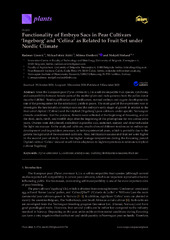Functionality of Embryo Sacs in Pear Cultivars 'Ingeborg' and 'Celina' as Related to Fruit Set under Nordic Climate
Чланак у часопису (Објављена верзија)
Метаподаци
Приказ свих података о документуАпстракт
Since the European pear (Pyrus communis L.) is a self-incompatible fruit species, synchrony and compatibility between female parts of the mother plant and male gametes from the pollen donor must be fulfilled. Besides pollination and fertilization, normal embryo and zygote development is one of the prerequisites for the satisfactory yields in pears. The main goal of this experiment was to investigate the functionality of embryo sacs and the embryo's early stages of growth in relation to the fruit set of diploid ('Celina') and the triploid ('Ingeborg') pear cultivars under specific Norwegian climatic conditions. For this purpose, flowers were collected at the beginning of flowering, and on the third, sixth, ninth, and twelfth days after the beginning of this phenophase for two consecutive years. Ovaries were dehydrated, embedded in paraffin wax, sectioned, stained, and observed under the light microscope. In the analyzed cultivars, results showed different tendencies in embryo sac develo...pment and degradation processes, in both experimental years, which is probably due to the genetic background of the examined cultivars. Also, fertilization success and fruit set were higher in the second year of study due to the higher average temperature during the flowering period. Diploid cultivar 'Celina' showed much better adaptation to high temperatures in relation to triploid cultivar 'Ingeborg'.
Кључне речи:
Pyrus communis L. / cultivars / embryo sac / viability / fertilization success / fruit setИзвор:
Plants-Basel, 2020, 9, 12
DOI: 10.3390/plants9121716
ISSN: 2223-7747
PubMed: 33291400
WoS: 000602328900001
Scopus: 2-s2.0-85097279785
Институција/група
Inovacioni centar
TY - JOUR
AU - Cerović, Radosav
AU - Fotirić-Aksić, Milica
AU - Đorđevic, Milena
AU - Meland, Mekjell
PY - 2020
UR - http://TechnoRep.tmf.bg.ac.rs/handle/123456789/4738
AB - Since the European pear (Pyrus communis L.) is a self-incompatible fruit species, synchrony and compatibility between female parts of the mother plant and male gametes from the pollen donor must be fulfilled. Besides pollination and fertilization, normal embryo and zygote development is one of the prerequisites for the satisfactory yields in pears. The main goal of this experiment was to investigate the functionality of embryo sacs and the embryo's early stages of growth in relation to the fruit set of diploid ('Celina') and the triploid ('Ingeborg') pear cultivars under specific Norwegian climatic conditions. For this purpose, flowers were collected at the beginning of flowering, and on the third, sixth, ninth, and twelfth days after the beginning of this phenophase for two consecutive years. Ovaries were dehydrated, embedded in paraffin wax, sectioned, stained, and observed under the light microscope. In the analyzed cultivars, results showed different tendencies in embryo sac development and degradation processes, in both experimental years, which is probably due to the genetic background of the examined cultivars. Also, fertilization success and fruit set were higher in the second year of study due to the higher average temperature during the flowering period. Diploid cultivar 'Celina' showed much better adaptation to high temperatures in relation to triploid cultivar 'Ingeborg'.
T2 - Plants-Basel
T1 - Functionality of Embryo Sacs in Pear Cultivars 'Ingeborg' and 'Celina' as Related to Fruit Set under Nordic Climate
IS - 12
VL - 9
DO - 10.3390/plants9121716
ER -
@article{
author = "Cerović, Radosav and Fotirić-Aksić, Milica and Đorđevic, Milena and Meland, Mekjell",
year = "2020",
abstract = "Since the European pear (Pyrus communis L.) is a self-incompatible fruit species, synchrony and compatibility between female parts of the mother plant and male gametes from the pollen donor must be fulfilled. Besides pollination and fertilization, normal embryo and zygote development is one of the prerequisites for the satisfactory yields in pears. The main goal of this experiment was to investigate the functionality of embryo sacs and the embryo's early stages of growth in relation to the fruit set of diploid ('Celina') and the triploid ('Ingeborg') pear cultivars under specific Norwegian climatic conditions. For this purpose, flowers were collected at the beginning of flowering, and on the third, sixth, ninth, and twelfth days after the beginning of this phenophase for two consecutive years. Ovaries were dehydrated, embedded in paraffin wax, sectioned, stained, and observed under the light microscope. In the analyzed cultivars, results showed different tendencies in embryo sac development and degradation processes, in both experimental years, which is probably due to the genetic background of the examined cultivars. Also, fertilization success and fruit set were higher in the second year of study due to the higher average temperature during the flowering period. Diploid cultivar 'Celina' showed much better adaptation to high temperatures in relation to triploid cultivar 'Ingeborg'.",
journal = "Plants-Basel",
title = "Functionality of Embryo Sacs in Pear Cultivars 'Ingeborg' and 'Celina' as Related to Fruit Set under Nordic Climate",
number = "12",
volume = "9",
doi = "10.3390/plants9121716"
}
Cerović, R., Fotirić-Aksić, M., Đorđevic, M.,& Meland, M.. (2020). Functionality of Embryo Sacs in Pear Cultivars 'Ingeborg' and 'Celina' as Related to Fruit Set under Nordic Climate. in Plants-Basel, 9(12). https://doi.org/10.3390/plants9121716
Cerović R, Fotirić-Aksić M, Đorđevic M, Meland M. Functionality of Embryo Sacs in Pear Cultivars 'Ingeborg' and 'Celina' as Related to Fruit Set under Nordic Climate. in Plants-Basel. 2020;9(12). doi:10.3390/plants9121716 .
Cerović, Radosav, Fotirić-Aksić, Milica, Đorđevic, Milena, Meland, Mekjell, "Functionality of Embryo Sacs in Pear Cultivars 'Ingeborg' and 'Celina' as Related to Fruit Set under Nordic Climate" in Plants-Basel, 9, no. 12 (2020), https://doi.org/10.3390/plants9121716 . .



